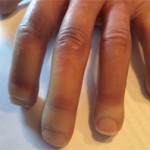“We’d like you to stay here at the hospital for a few days.” Dr. Medsger replied evenly. “Your elevated blood pressure is having an effect on the function of your kidneys. We need to aggressively …”
At this, Dr. Indura burst into tears. She’d managed the flight from New Mexico, the cramped seating and awkward transfers from the plane to a rental car to the hotel, a leaking connector to her intravenous line and the news that the University of Pittsburgh didn’t have a magic bullet for her scleroderma. Now, she was being told that her kidneys were damaged. She lay her head on the end table and sobbed.
Causes & Pathophysiology
The cause of progressive systemic sclerosis (diffuse scleroderma), like so many disorders in rheumatology, is unknown. Gerald P. Rodnan, MD, a mentor to Dr. Medsger at the University of Pittsburgh in the 1970s, devoted the majority of his professional life to the disease, and although he made a host of critical observations, was unable to consistently improve the crushing impact of the disease on his patients.
On the one hand, certain occupations that increase the exposure to chemicals, such as polyvinyl chloride, benzene or toluene, or the mining of coal or gold with chronic exposure to silica raise the risk in men for developing the disease.2 On the other hand, the majority of cases of diffuse scleroderma are in women with little or no industrial exposure.
Tryptophan supplementation in the early 1990s triggered a scleroderma-like disease: eosinophilic myalgia syndrome (EMS).3 The supplement, advertised as a sleep aid was linked to thickening of the skin, damage to peripheral nerves, lung inflammation and high levels of blood and tissue eosinophils. Although superficially, patients with the eosinophilic myalgia syndrome resembled patients with diffuse scleroderma, the disorder was clearly distinct. Mysteriously, the trigger for EMS was not felt to be the tryptophan itself, but a contaminant in the manufacturing process for the supplements.4 Except for rare, sporadic case of EMS in recent years, the epidemic resolved after the supplement was removed from the market.
Scleroderma may be a chronic immunologic reaction to ‘non-self’ cells—an unsuccessful attempt by the immune system to recognize & eliminate the cells of the previous generation.
Additional insights into the trigger(s) for diffuse scleroderma have been difficult to tease out. Genetic predisposition plays a role, but the rarity of the disorder, estimated at an annual incidence of only 19 cases per million, suggests that other risk factors may be in play beyond genetic risk alone.5



